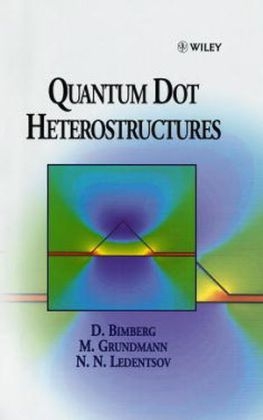
Quantum Dot Heterostructures
John Wiley & Sons Inc (Verlag)
978-0-471-97388-1 (ISBN)
Quantum Dot Heterostructures Dieter Bimberg, Marius Grundmann and Nikolai N. Ledentsov Institute of Solid State Physics, Technische Universität Berlin, Germany Quantum dots are nanometer-size semiconductor structures, and represent one of the most rapidly developing areas of current semiconductor research as increases in the speed and decreases in the size of semiconductor devices become more important. They present the utmost challenge to semiconductor technology, making possible fascinating novel devices. This important new reference book focuses on the key phenomena and principles. Chapter 1 provides a brief account of the history of quantum dots, whilst the second chapter surveys the various fabrication techniques used in the past two decades, and introduces the concept of self-organized growth. This topic is expanded in the following chapter, which presents a broad review of self-organization phenomena at surfaces of crystals. Experimental results on growth of quantum dot structures in many different systems and on their structural characterization are presented in Chapter 4. Basic properties of the dots relate to their geometric structure and chemical composition. Numerical modeling of the electronic and optical properties of real dots is presented in Chapter 5, together with general theoretical considerations on carrier capture, relaxation, recombination and properties of quantum dot lasers. Chapters 6 and 7 summarize experimental results on electronic, optical and electrical properties. The book concludes by disoussing highly topical results on quantum-dot-based photonic devices - mainly quantum dot lasers. Quantum Dot Heterostructures is written by some of the key researchers who have contributed significantly to the development of the field, and have pioneered both the theoretical understanding of quantum dot related phenomena and quantum dot lasers. It is of great interest to graduate and postgraduate students, and to researchers in semiconductor physics and technology and optoelectronics.
Dieter Bimberg is the author of Quantum Dot Heterostructures, published by Wiley. Professor Dr. Marius Grundmann has studied physics at the Technical University Berlin. He has worked on the epitaxy and the characterization of electronic and optical properties of semiconductor heterostructures and nanostructures and devices made from them.
Fabrication Techniques for Quantum Dots.
Self-Organization Concepts on Crystal Surfaces.
Growth and Structural Characterization of Self-Organized Quantum Dots.
Modeling of Ideal and Real Quantum Dots.
Electronic and Optical Properties.
Electrical Properties.
Photonic Devices.
References.
Index.
| Verlagsort | New York |
|---|---|
| Sprache | englisch |
| Maße | 166 x 239 mm |
| Gewicht | 624 g |
| Einbandart | gebunden |
| Themenwelt | Naturwissenschaften ► Physik / Astronomie ► Atom- / Kern- / Molekularphysik |
| Naturwissenschaften ► Physik / Astronomie ► Festkörperphysik | |
| Naturwissenschaften ► Physik / Astronomie ► Quantenphysik | |
| Technik ► Elektrotechnik / Energietechnik | |
| ISBN-10 | 0-471-97388-2 / 0471973882 |
| ISBN-13 | 978-0-471-97388-1 / 9780471973881 |
| Zustand | Neuware |
| Informationen gemäß Produktsicherheitsverordnung (GPSR) | |
| Haben Sie eine Frage zum Produkt? |
aus dem Bereich


